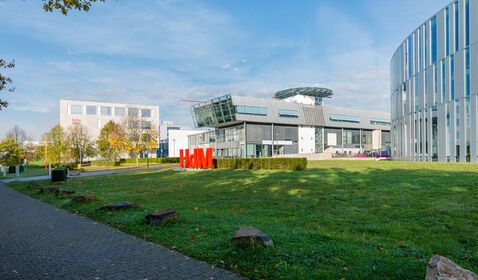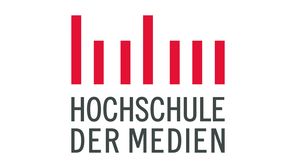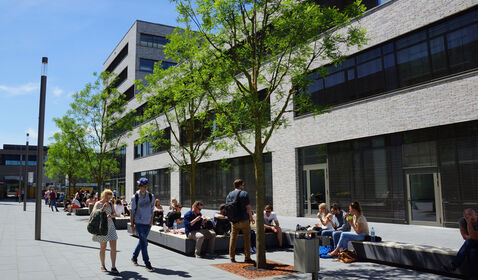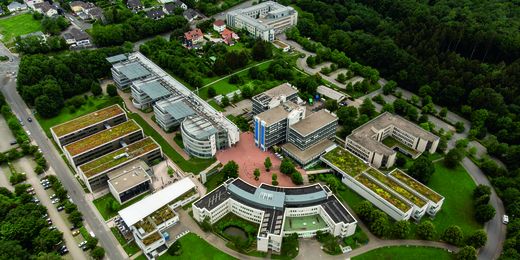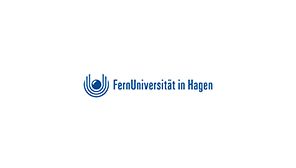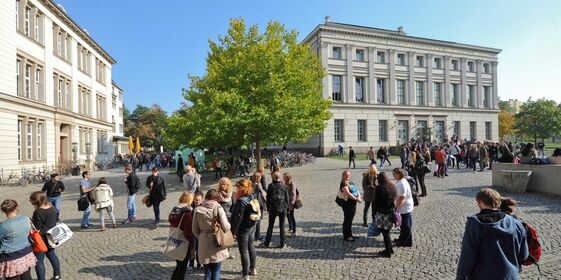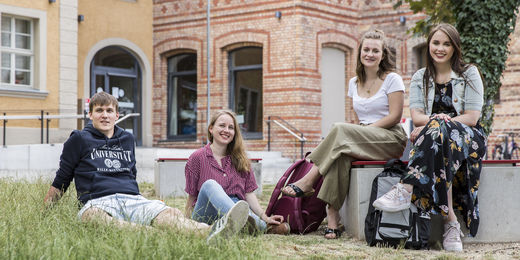Universität Stuttgart
- Promotionsrecht: Ja
- Trägerschaft: öffentlich-rechtlich
- 1829 gegründet
- 21.141 Studierende
Keplerstraße 7
70174 Stuttgart
Tel: 0711 685-0
Fax: 0711 685-82271
Hochschule im CHE-Ranking abschneiden.
Die Universität Stuttgart gehört zu den Universitäten.
Ja, du kannst an der Universität Stuttgart promovieren.
Die Universität Stuttgart ist eine öffentlich-rechtliche Hochschule. Es gibt staatliche und staatlich anerkannte Hochschulen, die meist in Universitäten, Fachhochschulen (international: University of Applied Sciences) und Kunst- sowie Musikhochschulen unterteilt werden. Der überwiegende Teil der Hochschulen wird vom Staat finanziert und befindet sich daher in staatlicher Trägerschaft. Dort fallen in der Regel nur geringe Semesterbeiträge an. An den privaten Hochschulen hingegen, die sich über private Trägerschaften finanzieren, können wesentlich höhere Studiengebühren anfallen. Einen Weg, die finanziellen Hürden dieser Hochschulen zu umgehen, können Stipendien darstellen.
Es gibt außerdem Hochschulen, die von der protestantischen oder katholischen Kirche betrieben werden.
Die Universität Stuttgart wurde im Jahr 1829 gegründet.
Insgesamt gibt es 21141 Studierende an der Universität Stuttgart.
Standort dieser Hochschule ist Stuttgart.
Hier findest du die Fristen und Termine für deine Bewerbung:
- Vorlesungszeit:
-
14.10.2024 - 08.02.2025Für Erstsemester (Bachelor und Master): Montag, 07. Oktober 2024
- Studienanfänger:
-
15.05.2024 - 15.09.2024
- Hochschulwechsler:
-
15.05.2024 - 15.09.2024
- International Studierende aus der Europäischen Union:
-
15.05.2024 - 15.09.2024
- International Studierende aus Staaten, die nicht Mitglied der EU sind:
-
Alle Informationen für internationale Studienbewerber/innen finden Sie unter: www.uni-stuttgart.de/studium/bewerbung/international-degree/
- Studienanfänger:
-
15.05.2024 - 15.07.2024
- Hochschulwechsler:
-
15.05.2024 - 15.07.2024
- International Studierende aus der Europäischen Union:
-
15.05.2024 - 15.07.2024
- International Studierende aus Staaten, die nicht Mitglied der EU sind:
-
Alle Informationen für internationale Studienbewerber/innen finden Sie unter: www.uni-stuttgart.de/studium/bewerbung/international-degree/
- Studienanfänger:
-
15.05.2024 - 15.07.2024
- International Studierende aus der Europäischen Union:
-
15.05.2024 - 15.07.2024
- International Studierende aus Staaten, die nicht Mitglied der EU sind:
-
Alle Informationen für internationale Studienbewerber/innen finden Sie unter: www.uni-stuttgart.de/studium/bewerbung/international-degree/
- Studienanfänger:
-
15.05.2024 - 15.07.2024
- International Studierende aus der Europäischen Union:
-
15.05.2024 - 15.07.2024
- International Studierende aus Staaten, die nicht Mitglied der EU sind:
-
Alle Informationen für internationale Studienbewerber/innen finden Sie unter: www.uni-stuttgart.de/studium/bewerbung/international-degree/
- Vorlesungszeit:
-
07.04.2025 - 19.07.2025
- Studienanfänger:
-
Für Bachelor-Studiengänge können Sie sich zum Sommersemester nur ins höhere Fachsemester bewerben. Bewerbungen ins erste Fachsemester (Studienbeginn) sind nur zum Wintersemester möglich.
- Hochschulwechsler:
-
01.12.2024 - 15.03.2025Die genauen Bewerbungstermine erfahren Sie auf der Webseite der Universität Stuttgart: www.uni-stuttgart.de/studium/bewerbung/wechsel/
- International Studierende aus der Europäischen Union:
-
Für Bachelor-Studiengänge können Sie sich zum Sommersemester nur ins höhere Fachsemester bewerben. Bewerbungen ins erste Fachsemester (Studienbeginn) sind nur zum Wintersemester möglich.
- International Studierende aus Staaten, die nicht Mitglied der EU sind:
-
Alle Informationen für internationale Studienbewerber/innen finden Sie unter: www.uni-stuttgart.de/studium/bewerbung/international-degree/
- Studienanfänger:
-
Für Bachelor-Studiengänge können Sie sich zum Sommersemester nur ins höhere Fachsemester bewerben. Bewerbungen ins erste Fachsemester (Studienbeginn) sind nur zum Wintersemester möglich.
- Hochschulwechsler:
-
01.12.2024 - 15.01.2025Die genauen Bewerbungstermine erfahren Sie auf der Webseite der Universität Stuttgart: www.uni-stuttgart.de/studium/bewerbung/wechsel/
- International Studierende aus der Europäischen Union:
-
Für Bachelor-Studiengänge können Sie sich zum Sommersemester nur ins höhere Fachsemester bewerben. Bewerbungen ins erste Fachsemester (Studienbeginn) sind nur zum Wintersemester möglich.
- International Studierende aus Staaten, die nicht Mitglied der EU sind:
-
Alle Informationen für internationale Studienbewerber/innen finden Sie unter: www.uni-stuttgart.de/studium/bewerbung/international-degree/
- Studienanfänger:
-
01.12.2024 - 15.01.2025
- International Studierende aus der Europäischen Union:
-
01.12.2024 - 15.01.2025
- International Studierende aus Staaten, die nicht Mitglied der EU sind:
-
01.12.2024 - 15.01.2025Alle Informationen für internationale Studienbewerber/innen finden Sie unter: www.uni-stuttgart.de/studium/bewerbung/international-degree/
- Studienanfänger:
-
01.12.2024 - 15.01.2025
- International Studierende aus der Europäischen Union:
-
01.12.2024 - 15.01.2025
- International Studierende aus Staaten, die nicht Mitglied der EU sind:
-
01.12.2024 - 15.01.2025Alle Informationen für internationale Studienbewerber/innen finden Sie unter: www.uni-stuttgart.de/studium/bewerbung/international-degree/
- Vorlesungszeit:
-
14.10.2024 - 08.02.2025Für Erstsemester (Bachelor und Master): Montag, 07. Oktober 2024
- Studienanfänger:
-
15.05.2024 - 15.09.2024
- Hochschulwechsler:
-
15.05.2024 - 15.09.2024
- International Studierende aus der Europäischen Union:
-
15.05.2024 - 15.09.2024
- International Studierende aus Staaten, die nicht Mitglied der EU sind:
-
Alle Informationen für internationale Studienbewerber/innen finden Sie unter: www.uni-stuttgart.de/studium/bewerbung/international-degree/
- Studienanfänger:
-
15.05.2024 - 15.07.2024
- Hochschulwechsler:
-
15.05.2024 - 15.07.2024
- International Studierende aus der Europäischen Union:
-
15.05.2024 - 15.07.2024
- International Studierende aus Staaten, die nicht Mitglied der EU sind:
-
Alle Informationen für internationale Studienbewerber/innen finden Sie unter: www.uni-stuttgart.de/studium/bewerbung/international-degree/
- Studienanfänger:
-
15.05.2024 - 15.07.2024
- International Studierende aus der Europäischen Union:
-
15.05.2024 - 15.07.2024
- International Studierende aus Staaten, die nicht Mitglied der EU sind:
-
Alle Informationen für internationale Studienbewerber/innen finden Sie unter: www.uni-stuttgart.de/studium/bewerbung/international-degree/
- Studienanfänger:
-
15.05.2024 - 15.07.2024
- International Studierende aus der Europäischen Union:
-
15.05.2024 - 15.07.2024
- International Studierende aus Staaten, die nicht Mitglied der EU sind:
-
Alle Informationen für internationale Studienbewerber/innen finden Sie unter: www.uni-stuttgart.de/studium/bewerbung/international-degree/
- Vorlesungszeit:
-
07.04.2025 - 19.07.2025
- Studienanfänger:
-
Für Bachelor-Studiengänge können Sie sich zum Sommersemester nur ins höhere Fachsemester bewerben. Bewerbungen ins erste Fachsemester (Studienbeginn) sind nur zum Wintersemester möglich.
- Hochschulwechsler:
-
01.12.2024 - 15.03.2025Die genauen Bewerbungstermine erfahren Sie auf der Webseite der Universität Stuttgart: www.uni-stuttgart.de/studium/bewerbung/wechsel/
- International Studierende aus der Europäischen Union:
-
Für Bachelor-Studiengänge können Sie sich zum Sommersemester nur ins höhere Fachsemester bewerben. Bewerbungen ins erste Fachsemester (Studienbeginn) sind nur zum Wintersemester möglich.
- International Studierende aus Staaten, die nicht Mitglied der EU sind:
-
Alle Informationen für internationale Studienbewerber/innen finden Sie unter: www.uni-stuttgart.de/studium/bewerbung/international-degree/
- Studienanfänger:
-
Für Bachelor-Studiengänge können Sie sich zum Sommersemester nur ins höhere Fachsemester bewerben. Bewerbungen ins erste Fachsemester (Studienbeginn) sind nur zum Wintersemester möglich.
- Hochschulwechsler:
-
01.12.2024 - 15.01.2025Die genauen Bewerbungstermine erfahren Sie auf der Webseite der Universität Stuttgart: www.uni-stuttgart.de/studium/bewerbung/wechsel/
- International Studierende aus der Europäischen Union:
-
Für Bachelor-Studiengänge können Sie sich zum Sommersemester nur ins höhere Fachsemester bewerben. Bewerbungen ins erste Fachsemester (Studienbeginn) sind nur zum Wintersemester möglich.
- International Studierende aus Staaten, die nicht Mitglied der EU sind:
-
Alle Informationen für internationale Studienbewerber/innen finden Sie unter: www.uni-stuttgart.de/studium/bewerbung/international-degree/
- Studienanfänger:
-
01.12.2024 - 15.01.2025
- International Studierende aus der Europäischen Union:
-
01.12.2024 - 15.01.2025
- International Studierende aus Staaten, die nicht Mitglied der EU sind:
-
01.12.2024 - 15.01.2025Alle Informationen für internationale Studienbewerber/innen finden Sie unter: www.uni-stuttgart.de/studium/bewerbung/international-degree/
- Studienanfänger:
-
01.12.2024 - 15.01.2025
- International Studierende aus der Europäischen Union:
-
01.12.2024 - 15.01.2025
- International Studierende aus Staaten, die nicht Mitglied der EU sind:
-
01.12.2024 - 15.01.2025Alle Informationen für internationale Studienbewerber/innen finden Sie unter: www.uni-stuttgart.de/studium/bewerbung/international-degree/




